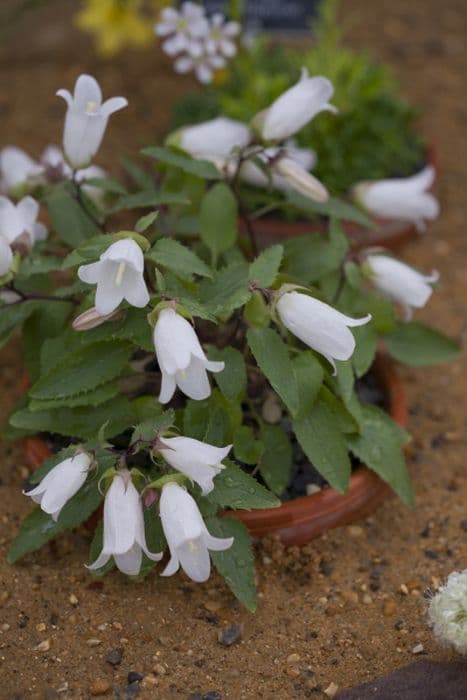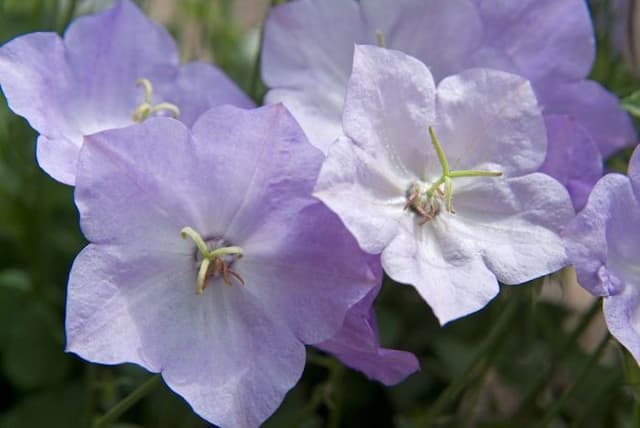Lobed-leaved cyananth Cyananthus lobatus

ABOUT
C. lobatus is a perennial forming a mat of prostrate stems to 30cm across, with small, lobed or toothed, dull green leaves. Flowers up to 4cm in width, blue, rarely white, opening in late summer
About this plant
 Names
NamesSynonyms
Trailing Bellflower
Common names
Cyananthus lobatus var. ellipsoideus, Cyananthus lobatus var. oblongus.
 Characteristics
CharacteristicsLife cycle
Perennials
Foliage type
Deciduous
Color of leaves
Green
Flower color
Blue
Height
1 feet [30 cm]
Spread
1 feet [30 cm]
Plant type
Herb
Hardiness zones
5
Native area
Himalayas
Benefits
 General Benefits
General Benefits- Ornamental value: Cyananthus lobatus, commonly known as Trailing Bellflower, is often cultivated for its beautiful blue or purple bell-shaped flowers, which add aesthetic appeal to gardens and landscapes.
- Habitat support: The flowers of Trailing Bellflower provide nectar for a variety of pollinators, including bees and butterflies, thus supporting local biodiversity.
- Erosion control: Being a low-growing and spreading plant, Trailing Bellflower can help stabilize soil and prevent erosion in sloped gardens or areas prone to soil degradation.
- Low maintenance: Trailing Bellflower is known for being a hardy plant that requires minimal care, making it a good choice for low-maintenance gardens and landscaping.
- Drought tolerance: The plant is relatively drought-resistant once established, making it suitable for rock gardens and xeriscaping in dry regions.
 Medical Properties
Medical Properties- This plant is not used for medical purposes.
 Air-purifying Qualities
Air-purifying QualitiesThis plant is not specifically known for air purifying qualities.
 Other Uses
Other Uses- Cyananthus lobatus, commonly known as 'Trailing bellflower', can be used for ornamental purposes in rock gardens, due to its low-growing habit and attractive blue flowers.
- The dried parts of the Trailing bellflower can serve as components in potpourri mixtures, contributing a natural and earthy element to the blend.
- Its vibrant flowers can be a natural dye source for fabrics, providing hues of blue depending on the mordant used.
- The plant can be included in butterfly gardens to attract and provide nectar for various species of butterflies and other beneficial insects.
- The foliage of the Trailing bellflower can be used as a subtle green filler in floral arrangements and bouquets.
- Its ground cover capability makes it a suitable living mulch, suppressing weeds and retaining soil moisture in garden beds.
- The plant's stems and leaves can be used in crafting, such as in the creation of natural wreaths and other decorative items.
- Trailing bellflower can be used in educational settings such as biology classes for studies on plant growth and flower development.
- In photography and art, the picturesque appearance of the Trailing bellflower can be a motif or subject for botanical illustration and nature photography.
- Cyananthus lobatus can serve as a companion plant, providing ground cover that supports the biodiversity of an area and enhances the overall garden ecosystem.
Interesting Facts
 Feng Shui
Feng ShuiThe plant Cyananthus lobatus is not used in Feng Shui practice.
 Zodiac Sign Compitability
Zodiac Sign CompitabilityThe plant Cyananthus lobatus is not used in astrology practice.
 Plant Symbolism
Plant Symbolism- Resilience: Cyananthus lobatus, commonly known as Trailing Bellflower, is accustomed to growing in harsh mountainous environments, symbolizing the ability to withstand difficult conditions and bounce back.
- Adaptability: As a plant that thrives in rocky terrains, the Trailing Bellflower represents the ability to adapt to various situations and make the most of the available resources.
- Persistence: The nature of this plant to vigorously pursue growth in challenging ecosystems signifies persistence and the determination to keep going despite obstacles.
 Water
WaterTrailing bellflower, commonly known as Cyananthus lobatus, should be watered thoroughly but infrequently, allowing the soil to dry out between waterings. Typically, it requires watering once every 1 to 2 weeks, depending on the climate and indoor conditions. Use about one quart of water for each watering session during the active growing season in spring and summer. During the fall and winter, reduce watering to every 2 to 3 weeks with slightly less water, as the plant's growth slows. Ensure proper drainage to prevent root rot.
 Light
LightThe trailing bellflower thrives best in full sun to partial shade. It prefers a spot that receives at least six hours of sunlight a day, with dappled afternoon shade in hot climates. For the healthiest growth, position it in a location where morning sun is abundant, which typically provides an ideal balance of light.
 Temperature
TemperatureThe trailing bellflower favors cool to moderate temperatures, optimally between 50°F and 75°F. It can tolerate a minimum temperature of around 30°F, but frost can damage the plant. During hot weather, ensure that temperatures don't exceed 80°F for prolonged periods, as excessive heat can stress the plant.
 Pruning
PruningPruning the trailing bellflower helps to maintain its shape, encourage bushier growth, and remove any dead or damaged stems. Prune in early spring as new growth appears, cutting back up to one-third of the plant. Deadheading, or removing spent flowers, promotes continued blooming throughout the season.
 Cleaning
CleaningAs needed
 Soil
SoilTrailing Bellflower thrives in well-draining, loamy or sandy soil enriched with organic matter. The ideal pH for this plant should be slightly acidic to neutral, ranging from 5.5 to 7. A mixture comprising equal parts of potting soil, peat, and perlite or coarse sand can provide the necessary drainage and aeration.
 Repotting
RepottingTrailing Bellflower should be repotted when it outgrows its container, generally every two to three years. The best time for repotting is in the spring when the plant is resuming growth.
 Humidity & Misting
Humidity & MistingTrailing Bellflower prefers moderate humidity but is quite adaptable to drier conditions. Aiming for 40-50% humidity around the plant would be ideal; however, it tolerates a wide range of humidity levels.
 Suitable locations
Suitable locationsIndoor
Ensure bright, indirect light and cool temperatures.
Outdoor
Plant in partial shade and protect from intense sun.
Hardiness zone
5-9 USDA
 Life cycle
Life cycleCyananthus lobatus, also known as Trailing Bellflower, begins its life cycle as a seed, typically germinating in cool, moist conditions often found in alpine or subalpine environments. Upon germination, the seedling emerges and develops into a vegetative plant, characterized by its low, trailing stems and small, lobed leaves. As the plant matures, it enters the flowering stage during the summer months, producing small, blue to purple, bell-shaped flowers that are pollinated by insects. Following pollination, the flowers develop into seed capsules containing numerous tiny seeds. The plant then enters a period of dormancy, especially in colder climates, where it can survive under snow cover or in the cool winter soil. With the arrival of spring, the cycle resumes as the plant emerges from dormancy, ready to grow and reproduce once more.
 Propogation
PropogationPropogation time
Spring to summer
The most popular method of propagation for Cyananthus lobatus, commonly known as Trailing Bellflower, is by seed. The best time to sow the seeds is in spring after the risk of frost has passed. The seeds should be scattered on the surface of a well-draining seed starting mix and lightly pressed into the soil. They need light to germinate, so they shouldn't be covered with soil. The seed tray should be kept in a warm place with temperatures around 70°F (approximately 21°C) and maintained moist with a gentle mist. Germination typically occurs within two to three weeks. Seedlings can then be carefully transplanted to individual pots when they are large enough to handle and eventually moved outdoors once they are established and there is no more danger of frost.









